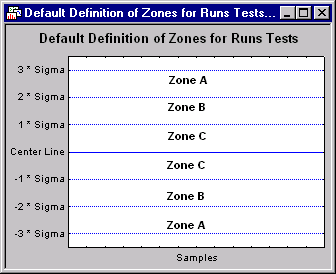Quality Control Introductory Overview - Out-of-Control Process: Runs Tests
As mentioned earlier in the introduction, when a sample point (e.g., mean in an X-bar chart) falls outside the control lines, one has reason to believe that the process may no longer be in control. In addition, one should look for systematic patterns of points (e.g., means) across samples, because such patterns may indicate that the process average has shifted. The Quality Control module will (optionally) perform the standard set of tests for such patterns; these tests are also sometimes referred to as AT&T runs rules (see AT&T, 1959) or tests for special causes (e.g., see Nelson, 1984, 1985; Grant and Leavenworth, 1980; Shirland, 1993). The term special or assignable causes as opposed to chance or common causes was used by Shewhart to distinguish between a process that is in control, with variation due to random (chance) causes only, from a process that is out of control, with variation that is due to some non-chance or special (assignable) factors (cf. Montgomery, 1991, p. 102).
As the sigma control limits discussed earlier, the runs rules are based on "Statistical" reasoning. For example, the probability of any sample mean in an X-bar control chart falling above the center line is equal to 0.5, provided 1) that the process is in control (i.e., that the center line value is equal to the population mean), 2) that consecutive sample means are independent (i.e., not auto-correlated), and 3) that the distribution of means follows the normal distribution. Simply stated, under those conditions there is a 50-50 chance that a mean will fall above or below the center line. Thus, the probability that two consecutive means will fall above the center line is equal to 0.5 times 0.5 = 0.25.
Accordingly, the probability that 9 consecutive samples (or a run of 9 samples) will fall on the same side of the center line is equal to 0.59 = .00195. Note that this is approximately the probability with which a sample mean can be expected to fall outside the 3-times sigma limits (given the normal distribution, and a process in control). Therefore, one could look for 9 consecutive sample means on the same side of the center line as another indication of an out-of-control condition. Refer to Duncan (1974) for details concerning the "Statistical" interpretation of the other (more complex) tests.
The Quality Control module will perform several such tests for special causes (runs tests) for X-bar, R, S, C, U, P, and Np charts, and highlight out-of-control runs in the chart.
The following is a description of the runs tests.

By default, Zone A is defined as the area between 2 and 3 times sigma above and below the center line; Zone B is defined as the area between 1 and 2 times sigma, and Zone C is defined as the area between the center line and 1 times sigma.